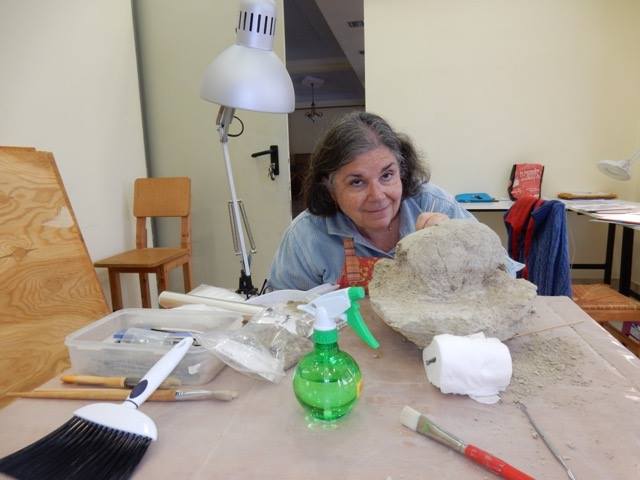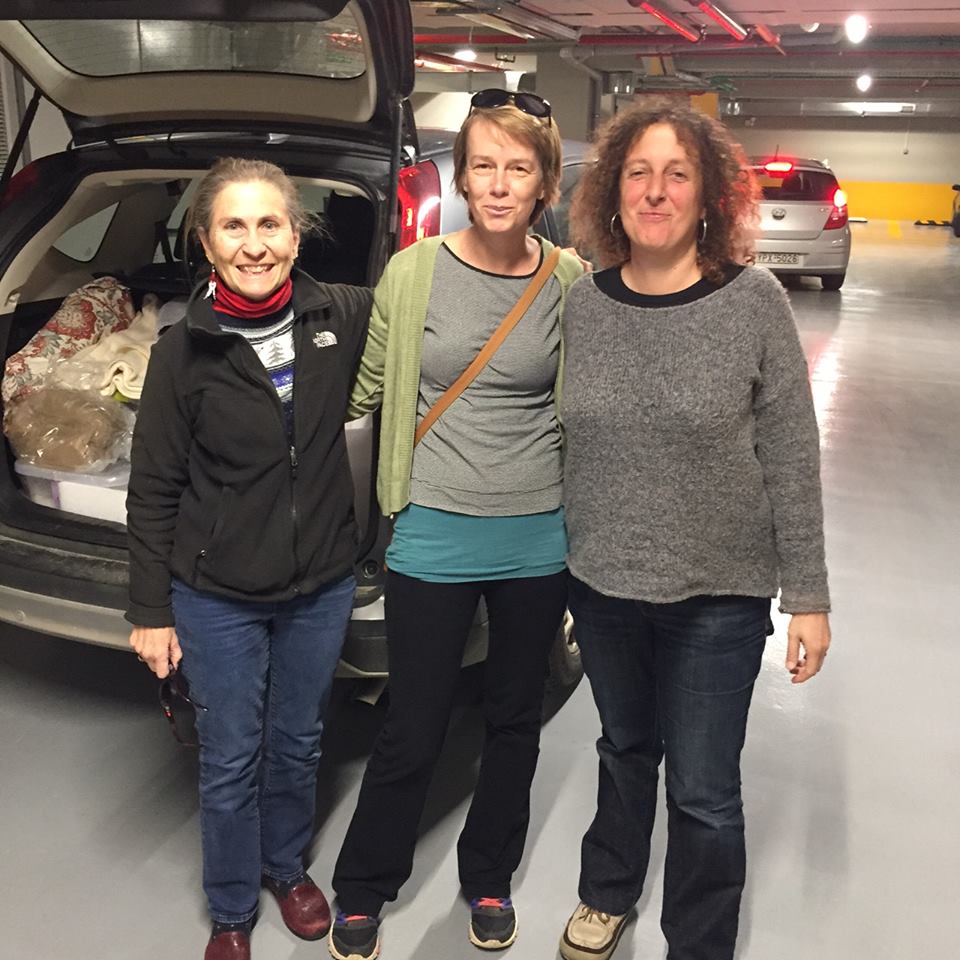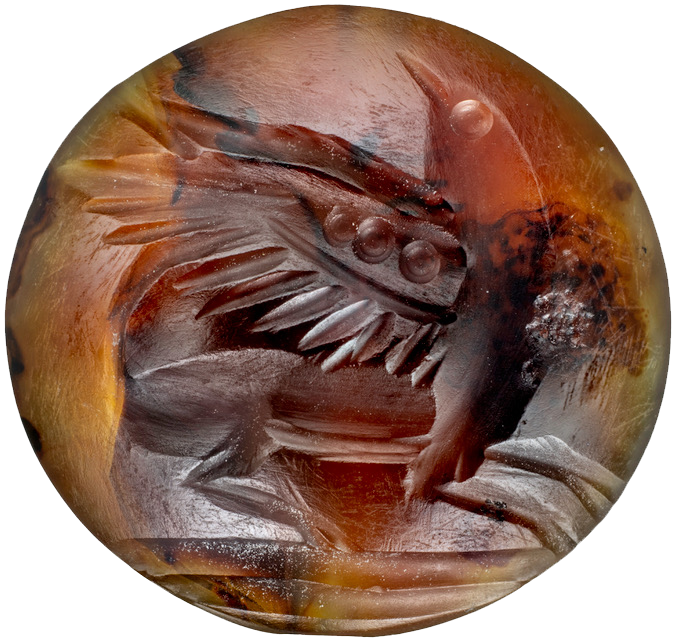Conservation & Research
There’s plenty to do beyond our work in the field. What we uncover during each excavation season goes on to be catalogued, conserved, and eventually used for research.
2020
In February, a team of visiting conservators including Kathy Hall, Maria Tziotziou, Lydia Avlonitou and Teresa Jiménez-Millas joined resident conservator Katie Cook for a dedicated conservation season. Julie Unruh joined Katie shortly afterwards for the spring excavation season. They worked on finds from the Griffin Warrior Tomb as well as ones from the tholos tombs.
Over the course of the spring and summer excavation seasons, osteoarchaeologists Lynne Schepartz and Christina Koureta analyzed bones from our excavations at Romanou and the tholos tombs.
In April, project co-directors Dr. Sharon Stocker and Dr. Jack Davis were scheduled to present a Boshell Foundation Lecture entitled “The Grave of the Griffin Warrior in Pylos, Greece,” at the Field Museum of Natural History in Chicago but the event was cancelled precautionarily due to the COVID-19 pandemic.
“Two New Linear B Tablets and an Enigmatic Find from Bronze Age Pylos (Palace of Nestor)” by Anna P. Judson, John Bennet, Jack L. Davis and Sharon R. Stocker was published in the journal Kadmos. It discusses three fragments of tablets discovered near the Palace of Nestor between 2017 and 2018.
“An Early Mycenaean Wanax at Pylos? On Genii and Sun-Disks from the Grave of the Griffin Warrior” by Sharon R. Stocker and Jack L. Davis was published as part of the AEGIS (Aegean Interdisciplinary Studies) series through Presses Universitaires de Louvain.
2019
Five academic articles about the Griffin Warrior attracted a surge of attention when they were temporarily made accessible for free.
As the 105th Sather Professor at UC Berkeley, Jack Davis presented a series of six lectures, which were designed to set the Griffin Warrior in his social and political context and to consider his place in the history of Greek prehistory.
2018
Sharon Stocker and Jack Davis presented an introduction to the Griffin Warrior at the EG XII Conference in Carmel-by-the-Sea, California.
A team consisting of researchers from the University of Vienna and Harvard University began studying DNA samples they collected from the Griffin Warrior.
In November, in a Vienna workshop focused on the destructions of the Mycenaean palaces, Salvatore Vitale, Sharon Stocker, and Jack Davis presented relevant evidence for the catastrophes that affected the Palace of Nestor and its LH IIIA predecessor during the 14th and the early 12th century B.C.E. Within this contribution, they provided a refined dating for these events, as well as a methodological case study concerning the use of pottery for chronology within its broader archaeological context.
2017

“The Combat Agate from the Grave of the Griffin Warrior at Pylos” by Sharon Stocker and Jack Davis was published in the October-December issue of Hesperia.
2016
In September, Salvatore Vitale completed the study of the early Mycenaean pottery sequence revealed on the Ano Englianos ridge during the excavations carried out in preparation for the new roof over the Palace of Nestor. The results of this work, conducted in collaboration with Sharon Stocker and Evangelia Malapani, were presented at the conference “Social Place and Space in Early Mycenaean Greece” and provided new evidence for pottery consumption trends and relevant cultural practices at Pylos during the 15th century B.C.E.
Paleobotanists from the University of Thessaloniki came to study our finds.

In February, the warrior’s head and pelvis travelled to the hospital in Kalamata for a CT scan before being removed from their earth matrix by Lynne Schepartz and Toby Holton of the University of Witwatersrand in Johannesburg.
Efi Tsolaki, who was in the process of restudying material from PRAP for her Ph.D. thesis, cleaned the storeroom in which PRAP and MARWP finds had been stored since the 1990s. She checked the integrity of storage containers and made improvements to the storeroom.
Through conservation, we discovered that a bronze object we had thought was a meathook (κρεάγρα) is instead the animal-headed grip of a staff or scepter. Similarly, conservators revealed a decorative pattern of delicately carved rosettes on the ivory handle of the bronze mirror found in the Griffin Warrior Tomb.
During July, Salvatore Vitale studied the pottery fragments from the construction fills located within and outside the grave of the Griffin Warrior in order to establish their defining characteristics and chronological range.
In January, textile expert Christina Margariti visited Chora to examine remains of cloth that may be from a burial shroud.
Nefeli Theocharous, Wendy Reade, and Kathy Hall continued conservation work.
In April, Georgia Tsartsidou of the Ephorate of Paleoanthropology and Speleology of Southern Greece began looking for phytoliths in soil from the Griffin Warrior Tomb.
In preparation for a monograph, Hariclia Brecoulaki studied fragments from Blegen’s excavations of Hall 64.
Emily Egan studied fragments of painted plaster that were uncovered during the excavations carried out in preparation for the new roof over the Palace of Nestor. She reported on those that are of LH I-IIIA date at the conference “Social Place and Space in Early Mycenaean Greece” in October in Athens.

Specialists Tobias Houlton and Lynne Schepartz from University of Witwatersrand created a reconstruction of the Griffin Warrior’s face.
In March, Andreas Karydas and Vicki Kandarelou of the Democritos Institute conducted XRF analysis of some of the grave goods.
Photographer Chronis Polychronakis documented our finds.
Tina Ross completed drawings of all of the seals from the grave of the Griffin Warrior, including the one that serves as our project logo, a small carnelian lentoid containing an image of a griffin. The collection sets a new record for the number of seals associated with a single Mycenaean burial, nearly doubling that excavated by Christos Tsountas in the cist beneath the tholos at Vapheio in 1889.

One early morning in December, 14 artifacts from the Grave of the Griffin Warrior traveled with Shari Stocker, Kathy Hall, Nefeli Theocharous, and a police escort from Messenia to the Wiener Laboratory of the American School of Classical Studies in Athens. There they were met by lab director, Takis Karkanas, and Dimitris Michailidis, who helped unload the artifacts.
“The Lord of the Gold Rings: The Griffin Warrior of Pylos” by Jack Davis and Sharon Stocker was published in Hesperia.
2015
Maria Dinou studied carbonized plant matter.
Andreas Karydas and Vicky Kontarelou studied metals composition.
Georgia Tsartsidou began to look for phytoliths in soil samples.
Takis Karkanas prepared micromorphological samples.

